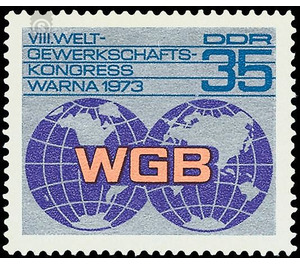World Trade Union Congress, Varna 1973 - Germany / German Democratic Republic 1973 - 35 Pfennig
Theme: Devices, Items & Instruments
| Country | Germany / German Democratic Republic |
| Issue Date | 1973 |
| Face Value | 35.00 |
| Color | multi-colored |
| Perforation | K 14 |
| Printing Type | Rotogravure 2 |
| Stamp Type | Postage stamp |
| Item Type | Stamp |
| Chronological Issue Number | 1627 |
| Chronological Chapter | GER-DDR |
| SID | 618579 |
| In 23 Wishlists | |
VIII. World Trade Union Congress in Varna 1973 To VIll. World Trade Union Congress in Varna In 1973, the Ministry of Posts and Telecommunications of the German Democratic Republic issues a multicolored postage stamp. VIII. World Trade Union Congress in Varna 1973 From October 15 to 22, 1973 in Varna, People's Republic of Bulgaria, VIll. World Trade Union Congress held. World Trade Union Congresses, which are held every four years by statute, are the supreme governing body of the World Trade Union Confederation (WGB), which, with around 150 million members in more than 60 countries, is the largest and most comprehensive international trade union federation. The WFT was created in 1945 as a result of the decades-long struggle of the revolutionary and progressive trade unionists of the world for the unity of all trade union directions and for the representation of the class interests of the workers. The splitting of the WFTU in 1949, carried out by the reformist trade union leaders of North America, Great Britain and Holland - and the subsequent founding of the ICFTU - could not stop its growth. He is still the only international trade union federation to include trade unions from socialist as well as capitalist countries and young nation states. In addition to the trade union confederations of the socialist countries, its members include the largest trade unions in France (CGT), Italy (CGIL), India (AITUC) and other countries in Asia, Africa and Latin America. The FDGB has been a member of the WGB since 1 January 1949. Not only the member organizations of the WGB are invited to the world trade union congresses. They are open to all unions in the world. For example, such major autonomous unions as the SOHYO Japan and the CUT of Chile regularly took part in them. Regional trade union federations such as the Latin American Unity Central Unit, the Arab Trade Union Confederation and the All-African Union Confederation have also been permanent participants in World Trade Union Congresses since their inception. These are thus distinguished by their broad composition and above all by their firm class standpoint and militant spirit of congresses of other international trade union organizations, the International Confederation of Free Trade Unions (ICFTU), which still has about 50 million members, and the World Federation of Workers (WCO) about 14 million members. Since its founding, the WFTU has pursued the goal of creating a world order from which social injustice and all forms of human exploitation are banned. He mobilizes the working people for a common struggle for democracy, national independence and social progress to beat the forces of reaction and imperialism, colonialism and neocolonialism. His congresses have always been great manifestations of fidelity to proletarian internationalism, clearly demonstrating the growing power of the working class and its unions in the world. At the founding congress in London in February 1945, trade unions from 40 countries took part, representing 60 million members. Twelve years later, at the IVth World Trade Union Congress in Leipzig, there were unions from 81 countries with 106 million members. At the last Congress in October 1969 in Budapest unions from 97 countries were represented, which counted a total of 153 million members. The progress towards peace and security achieved, above all, by the active peace policy of the Soviet Union and the socialist community of states in Europe and other parts of the world has created favorable conditions for the development of trade union relations. An increasing number of contacts, consultations and mutual delegation visits between organizations belonging to the WFTU, the ICFTU and the WCA have provided a good atmosphere for the comprehensive discussion of today's demands of the workers as well as the trade union tasks and rights on the forthcoming VIll. World Trade Union Congress created. It will certainly pay particular attention to questions of establishing the unions' unity of action in the fight against anti-worker policies of international monopoly societies, global solidarity and the possibility of restoring the organizational unity of the world trade union movement in the future. This corresponds to the symbol of the WGB, which shows the two halves of the globe, meaningfully expressing the global character of the organization.


